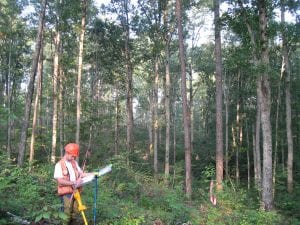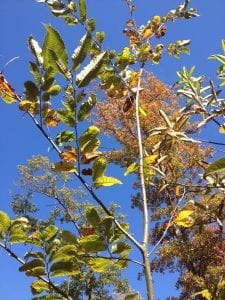By the 1950s, two non-native pathogens had killed almost all American chestnut trees. “There’s a lot of interest in breeding a chestnut that looks like American chestnut, but has the disease resistance of Chinese chestnut,” says U.S. Forest Service research forester Stacy Clark. “However, there hasn’t much research on reintroducing disease-resistant trees.”
Clark and SRS research forester Callie Schweitzer recently contributed to a new study on chestnut reintroduction. Cornelia Pinchot, a research ecologist at the Forest Service Northern Research Station led the study, which was published in the journal New Forests.

A thinned stand in the Daniel Boone National Forest. Photo by Callie Schweitzer, USFS.
In 2007, Clark and her colleagues harvested BC2F3 hybrid chestnut seeds from The American Chestnut Foundation’s Meadowview Research Farm. The American Chestnut Foundation and the Connecticut Agricultural Experiment Station have been breeding disease-resistant chestnut trees for decades, and the BC2F3 hybrids are potentially very blight-resistant.
In 2008, the scientists planted American chestnut, Chinese chestnut, and the hybrid chestnut in the Daniel Boone National Forest, Kentucky. The study was part of a larger Forest Service study designed to improve oak health before non-native gypsy moths invade.
The scientists used three different silvicultural methods – shelterwood, thinning, and mid-story removal. The treatments created a gradient of light levels, from sunny, to intermediate, to shady.
Seedling survival and growth were tracked until 2012. “We also compared chestnut seedlings to other trees and shrubs,” says Schweitzer. “Our goal was to see how well chestnut competes for nutrients and sunlight.”
Young American chestnuts can survive on the shady forest floor for decades, waiting for a disturbance to send some light their way. Their unique combination of shade tolerance and quick growth means managers could be able to use a range of silvicultural strategies to restore the species.
The results showed that most chestnut seedlings grew fastest in sunny plots. However, the other understory plants in sunny plots also grew quickly, overwhelming chestnut’s ability to compete for sunlight and nutrients.
“The intermediate light treatment gave chestnut the biggest advantage over other understory plants,” says Clark. “It’s critical to know how chestnut will interact with other species – especially since these ecosystems have changed dramatically.”
 One ecosystem threat has remained constant – root rot. Root rot is caused by Phytophthora cinnamomi, a water mold that lives in the soil and attacks trees’ roots. The water mold was accidentally introduced to the U.S. in the 1700s. By the late 1800s, it had killed most American chestnuts in moist sites throughout the southeast, and the chestnut blight fungus finished off the survivors.
One ecosystem threat has remained constant – root rot. Root rot is caused by Phytophthora cinnamomi, a water mold that lives in the soil and attacks trees’ roots. The water mold was accidentally introduced to the U.S. in the 1700s. By the late 1800s, it had killed most American chestnuts in moist sites throughout the southeast, and the chestnut blight fungus finished off the survivors.
The scientists found the water mold in every soil sample. It killed about 75 percent of the American chestnut trees as well as a large number of hybrid seedlings. In one hybrid family, only 21 percent of the seedling survived. The other hybrid family did better – 57 percent of seedlings survived, and 90 percent of the Chinese chestnut trees survived.
Before planting American chestnut, the scientists recommend testing the sites for the presence of P. cinnamomi. “We also suggest planting seedlings from many sources,” says Clark. “Pedigree can affect performance, so using seedlings from more than one population is wise.
Listen to a brief audio clip by author Cornelia Pinchot describing this publication.
